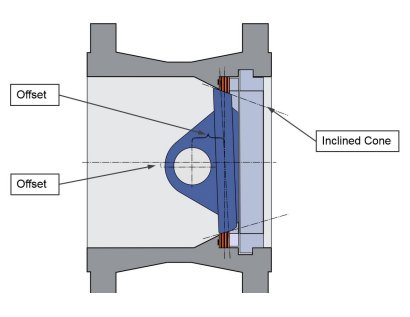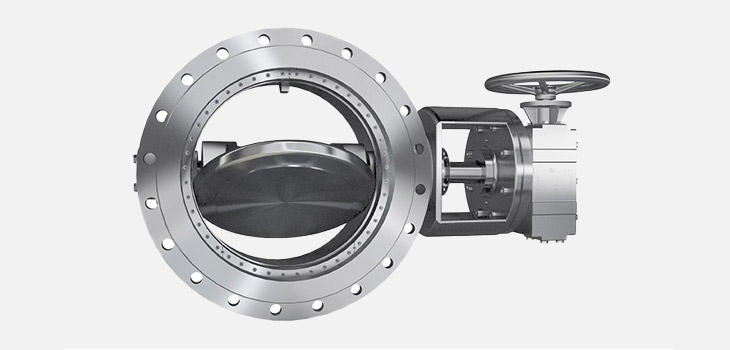The unique triple offset of the valve means the seating is affected with almost zero friction. The disc lifts off the seat without dragging across the surface. Because of this feature, these valves could be placed through 500,000 cycles of operation without any degradation in seating performance.
The diagram below illustrates the inclined conical sealing principle utilized by the triple offset design:

- Offset 1 – The inclined angle on the conical disc allows simultaneous engagement of the disc to the seat ring without friction.
- Offset 2 – Shaft centerline is offset from the pipe/valve centerline to provide the camming action.
- Offset 3 – Shaft centerline is offset away from the centerline of the disc and sealing surface, thus allowing uninterrupted metal to metal contact between the disc and seat ring.
The combination of these three offsets provides a disc lifting action, which ensures a frictionless (almost zero) repeatable seating. This triple offset camming action provides the wiping mechanism necessary for systems that are subject to media with abrasive, silting, scaling or biological growths. These growths or particles are swept away from the seating surfaces prior to disc and seat engagement, maintaining the leak tight integrity required in isolation/control applications.
Torque Seating
The key design feature in the triple offset design, torque seating combined with a body mounted metal-to-metal seat, allows the disc to routinely return to the proper closed position without using mechanical stops. It seats repeatedly with virtually no friction due to the triple offset design enhanced by the massive shaft (double flanged or ASME B16.10 end to end dimensions), disc and valve actuator interface. This feature, combined with margins on dynamic and static torques, leads to very consistent stroke times and 89-10 results.
In tight shut-off applications, it is critical to return the disc to its proper seating position during each cycle of operation.
The torque-seating feature of the triple offset valve means that you do not have to rely on actuator limit stops to determine the shut-off position of the disc. In the ADAMS valve design the actuator torques the disc into the seat in every cycle of operation. The actuator stops are only used to prevent over travel. This eliminates the major cause of leakage and failure in standard “position seating” butterfly valves.
Internal Design
The triple offset metal seated valve design is the optimum choice for cryogenic and gas liquids handling as there is no internal trapped cavity area for liquids to collect. In the event of liquids expansion, the pressure would simply move upstream or downstream within the piping system, thus causing no valve damage that can occur in wedge gate, plug, or ball valve type products.
The metal seated system of the triple offset valve will provide repeatable tight shutoff exceeding the criteria of ASME B16.104 Class VI, whereas metal seated designs of double offset valves are typically Class IV or V shutoff; soft seated versions are not capable of the low temperatures that can be seen in cryogenic applications. See below comparison between, where triple offset valves are tested according to API 598 Resilient Seat category.
| Leak Rate Comparison | ||||||||||
|---|---|---|---|---|---|---|---|---|---|---|
| ND | ANSI/FCI 70-2 CI. VI | API 598 | API 6D | ND | ||||||
| Metal Seated | Resilient Seated | |||||||||
| Air | Air | Liquid | Air | Liquid | Air | Liquid | ||||
| Bbl/Min | Bbl/Min | Drop/Min | Bbl/Min | Drop/Min | Bbl/Min | Drop/Min | ||||
| 3″ | 75mm | 6 | 24 | 12 | 0 | 0 | 0 | 0 | 75mm | 3″ |
| 4″ | 100mm | 11 | 24 | 12 | 0 | 0 | 0 | 0 | 100mm | 4″ |
| 6″ | 150mm | 27 | 24 | 12 | 0 | 0 | 0 | 0 | 150mm | 6″ |
| 8″ | 200mm | 45 | 40 | 20 | 0 | 0 | 0 | 0 | 200mm | 8″ |
| 10″ | 250mm | 70* | 40 | 20 | 0 | 0 | 0 | 0 | 250mm | 10″ |
| 12″ | 300mm | 100* | 40 | 20 | 0 | 0 | 0 | 0 | 300mm | 12″ |
| 14″ | 350mm | 136* | 56 | 28 | 0 | 0 | 0 | 0 | 350mm | 14″ |
| 16″ | 400mm | 176* | 56 | 28 | 0 | 0 | 0 | 0 | 400mm | 16″ |
| 18″ | 450mm | 225* | 56 | 28 | 0 | 0 | 0 | 0 | 450mm | 18″ |
| 20″ | 500mm | 278* | 56 | 28 | 0 | 0 | 0 | 0 | 500mm | 20″ |
| 24″ | 600mm | 400* | 56 | 28 | 0 | 0 | 0 | 0 | 600mm | 24″ |
| 30″ | 750mm | 620* | 56 | 28 | 0 | 0 | 0 | 0 | 750mm | 30″ |
| 36″ | 900mm | 900* | 56 | 28 | 0 | 0 | 0 | 0 | 900mm | 36″ |
| 1 Drop = 0.0625cm3 (16 Drops = 1 cm3) 1 Bubble = 0.15cm3 *Extrapolated Values Not Included in Test Standard |
||||||||||
Laminated Stainless
Steel and Graphite S eat Ring The seat has operated in harsh environments such as saturated steam, abrasive media, and with silt and rust particles in the flow stream, while providing long-term maintenance-free shut-off. Graphite enhances the rotary disc’s zero-leakage capability. It adds lubricity and fills voids during the “squeeze” taking place when the disc is rotated into the seating surface. The stainless-steel rings develop a flexible sealing system highly tolerant to deleterious effects of poor media conditions.
Conventional butterfly valves with soft seats, such as PTFE Teflon, ultra-high molecular weight polyethylene (UHMWPE) or elastomers, may be tolerant to the effects of radiation aging but will still require maintenance attention during outages. Closing or opening of the valve can position a disc in such a manner as to tear the soft seat during the action of repositioning the disc to seat after inspection for erosion or biological attachments.
Sear Retained in Body
Removal of the seat, if required, is a process employing the removal of standard set screws from a retaining ring. The valve will not require complete valve removal should damage occur to the seat ring if access to the seat ring is provided by a spool piece or access panel in the valve body. The simple field replacement of the seat ring does not require any special positioning, keeping down-time to a minimum.
Metal-to-Metal Seating
The standard metal-to-metal seating allows placing it into a broad range of services. Conventional soft-seated butterfly valves are placed into services where low and/or high temperature fluctuations and severe service conditions require special modifications which may not last. See Table 1, which provides a comparison for review of the ADAMS valve to conventional soft-seated butterfly valves. The ADAMS valve requires no modification in the same application.
Better than ASME Class VI Leak Integrity
Shut-off in the normal flow direction and up to 60% of rated pressure in the reverse direction is more than ASME Class VI, it is absolutely zero leakage, and can be tested with Helium. Flow in the reverse direction above 60% of rated pressure is equal to Class VI. This is achieved by the sealing system: triple offset, laminated stainless steel/graphite seat ring, and seat in body. This design means that for most services, the original triple offset valve will provide zero leakage isolation bi-directionally!
One Piece Shaft
The self-lubricated, corrosion-resistant shaft bearings are designed to eliminate body galling. The lower thrust bearing is a blowout-proof design. These features, combined with the single piece forged disc, provide trouble-free service, eliminating disc jamming or separation problems.
Oversized Drive Components
Another important feature for your application is the oversize drive components of the double flanged or ASME B16.10-dimension valves. By using a large disc and shaft combined with precision fit keys, hysteresis and dead band are eliminated. In continuous throttling service the disc and actuator drive system must act as an integrated unit to provide proper control. In addition, the slightest looseness will lead to vibration, oscillations, and rapid failure of internal valve components. This can be a serious concern in high performance butterfly valves which use wedge or taper pins in their drive systems.
